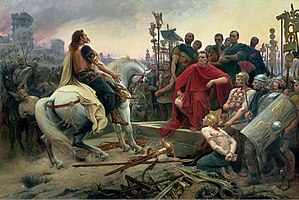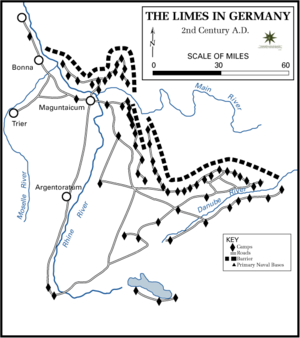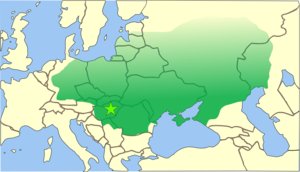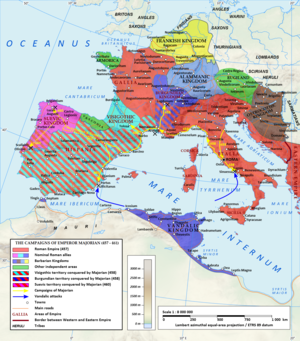


|
| |
|---|---|
Cimbrian War (113 BC – 101 BC) Gallic Wars (58 BC – 57 BC) Clades Lolliana (16 BC) Roman campaigns in Germania (12 BC – AD 16) Marcomannic Wars (166–180) (participating Roman units) Roman campaigns in Germania during the 230s Gothic invasion of the Balkans (250–251) Gothic invasion of the Balkans (254) Gothic invasion of the Balkans (267–268)
Gothic War (367–369) Visigothic Wars
Vandalic Wars
Anglo-Saxon Wars
Vandalic War (533–534) |
This is a chronology of warfare between the Romans and various Germanic peoples. The nature of these wars varied through time between Roman conquest, Germanic uprisings, later Germanic invasions of the Western Roman Empire that started in the late second century BC, and more. The series of conflicts was one factor which led to the ultimate downfall of the Western Roman Empire in particular and ancient Rome in general in 476.


Battles of Idistaviso and the Angrivarian Wall.

|
| |
|---|---|
250–251 254 267–269
Gothic War (323–332) Gothic War (401–403) Radagaisus' invasion Visigothic Wars |



For the timeline of events in Britannia after its abandonment by Emperor Valentinian III, see Timeline of conflict in Anglo-Saxon Britain.
|
Rome against the Anglo-Saxons
| |
|---|---|
|





|
| |||||||
|---|---|---|---|---|---|---|---|
Attested in Antiquity (ca. 3,000 BC–500 AD), Migration Period (c. 300–538 AD), and the Germanic Iron Age (c. 476–793) | |||||||
| Cherusci (c. 9 BCE–21 CE) |
| ||||||
| Marcomanni (c. 9 BCE–37 CE, c. 166–c. 172) |
| ||||||
| Suebi |
| ||||||
| Goths |
| ||||||
| Visigoths |
| ||||||
| Ostrogoths |
| ||||||
| Anglo-Saxons |
| ||||||
| Vandals |
| ||||||
| Burgundians |
| ||||||
| Lombards |
| ||||||
| Franks |
| ||||||
| Bavaria |
| ||||||
| Frisians |
| ||||||
| Norse |
| ||||||
|
| |||||
|---|---|---|---|---|---|
| General History |
| ||||
| Geography |
| ||||
| Politics |
| ||||
| Economy |
| ||||
| Society |
| ||||
|
| |||||